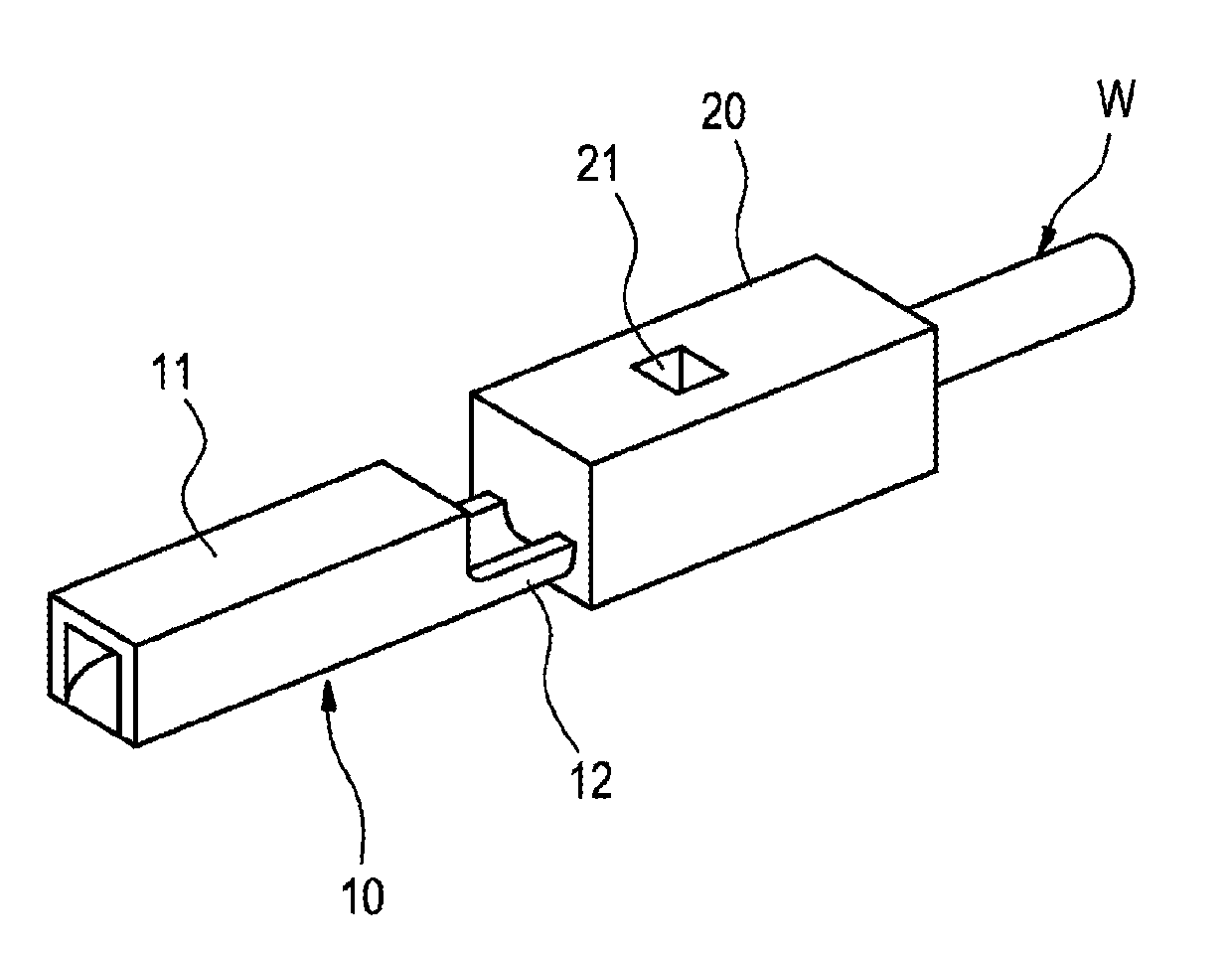Method of Resin Molding and System for Resin Molding
a technology of resin molding and electric wire end, which is applied in the direction of manufacturing tools, application, and connection of coupling devices, can solve the problems of difficult to manage resin thickness, and achieve the effect of easy management of resin thickness
- Summary
- Abstract
- Description
- Claims
- Application Information
AI Technical Summary
Benefits of technology
Problems solved by technology
Method used
Image
Examples
first embodiment
[0048]FIG. 1 is an illustrative figure of a resin molding method of the first embodiment, and is a side sectional view which shows that a terminal fitting is set in a metal mold to resin mold an electric wire end connecting part. FIG. 2 is a perspective view of the terminal fitting after a resin molded part is formed.
[0049]A terminal fitting 10 which is the same as that shown in FIG. 12A is used in the resin molding method of the first embodiment. As shown in FIG. 1, the terminal fitting 10 has an electrical contact part 11 to electrically contact a mating connector terminal at the front part, an electric wire connecting part 16 which is connected to an end portion of an electric wire W at the rear part, and a bridging part 12 arranged between the electrical contact part 11 and the electric wire connecting part 16. The electric wire connecting part 16 has a conductor crimping part 13, which is crimped to a conductor Wa which is exposed by stripping off a sheath Wb of the end portion...
second embodiment and third embodiment
[0054]In the first embodiment, the upper metal mold 2 has the protruding part 31 to interfere with the conductor crimping part 13 of the electric wire connecting part 16, but it is also possible that the upper metal mold 2 has a protruding part 32 at a position where the bridging part 14 of the electric wire connecting part 16 is interfered with the protruding part 21, as in the second embodiment shown in FIG. 3. Also, it is possible that the upper metal mold 2 has a protruding part 33 to interfere with the sheath crimping part 15 of the electric wire connecting part 16, as in the third embodiment shown in FIG. 4.
fourth embodiment
[0055]In the first to the third embodiments described above, a coping method when the terminal fitting 10 is bent upward / downward is described, but the method of this fourth embodiment is a coping method when the electric wire connecting part 16 at the rear part of the terminal fitting 10 is bent leftward and / or rightward relative to the electrical contact part 11 at the front part of the terminal fitting 10 as shown in FIG. 14A. As shown in FIG. 5, two side walls of the lower metal mold 3 in the accommodating space 4 are provided with partition walls 5 which press down the bridging part 12 located at the border between the front part and the rear part of the terminal fitting 10 to maintain positions and define the front end of the cavity 6.
[0056]The right and left inner side walls of the cavity 6 are provided with protruding parts 34 which interfere with the electric wire connecting part 16 and correct the electric wire connecting part 16 into an appropriate position (appropriate f...
PUM
| Property | Measurement | Unit |
|---|---|---|
| pressing force | aaaaa | aaaaa |
| corrosion resistance | aaaaa | aaaaa |
| electrolytic corrosion | aaaaa | aaaaa |
Abstract
Description
Claims
Application Information
 Login to View More
Login to View More - R&D
- Intellectual Property
- Life Sciences
- Materials
- Tech Scout
- Unparalleled Data Quality
- Higher Quality Content
- 60% Fewer Hallucinations
Browse by: Latest US Patents, China's latest patents, Technical Efficacy Thesaurus, Application Domain, Technology Topic, Popular Technical Reports.
© 2025 PatSnap. All rights reserved.Legal|Privacy policy|Modern Slavery Act Transparency Statement|Sitemap|About US| Contact US: help@patsnap.com



